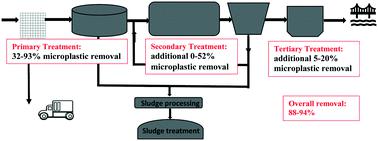当前位置:
X-MOL 学术
›
Environ. Sci.: Water Res. Technol.
›
论文详情
Our official English website, www.x-mol.net, welcomes your
feedback! (Note: you will need to create a separate account there.)
Microplastics removal in wastewater treatment plants: a critical review
Environmental Science: Water Research & Technology ( IF 3.5 ) Pub Date : 2020-08-26 , DOI: 10.1039/d0ew00397b Paul U. Iyare 1, 2, 3, 4 , Sabeha K. Ouki 1, 2, 3, 4 , Tom Bond 1, 2, 3, 4
Environmental Science: Water Research & Technology ( IF 3.5 ) Pub Date : 2020-08-26 , DOI: 10.1039/d0ew00397b Paul U. Iyare 1, 2, 3, 4 , Sabeha K. Ouki 1, 2, 3, 4 , Tom Bond 1, 2, 3, 4
Affiliation

|
Wastewater treatment plants (WWTPs) are an important route for microplastics to enter aquatic environments. Microplastics have been recently identified in sewage samples in Russia, Sweden, France, Finland, USA, UK, Netherlands, Germany, Canada, Australia, Italy, Turkey, Denmark, Poland, China and South Korea. The aim of this study was to examine and quantify the removal efficacy of microplastics by WWTPs. Experimental methods employed in sampling, analysis and quantification of microplastics vary widely between studies. Microplastic removal rates in 21 studies were compared. Secondary and tertiary WWTPs removed an average of 88% and 94% of microplastics, respectively. The majority of microplastics, 72% on average, were removed during preliminary and primary treatment. Calculations of the settling/floating velocities of commonly used polymers indicate that primary sedimentation removes spherical particles >27–149 μm in diameter, depending on the polymer in question. Thus, the majority of microplastics removed during wastewater treatment are likely to be present in sewage sludge. Although the removal of microplastics is high, WWTPs are still an important entry point into aquatic and terrestrial systems, given the high volumes involved and the amount of sludge reused via land application. The major concerns are with small particles (especially <∼150 μm) in discharged wastewater effluent and the impact that particles which accumulate in sewage sludge may have on terrestrial ecosystems.
更新日期:2020-10-02











































 京公网安备 11010802027423号
京公网安备 11010802027423号